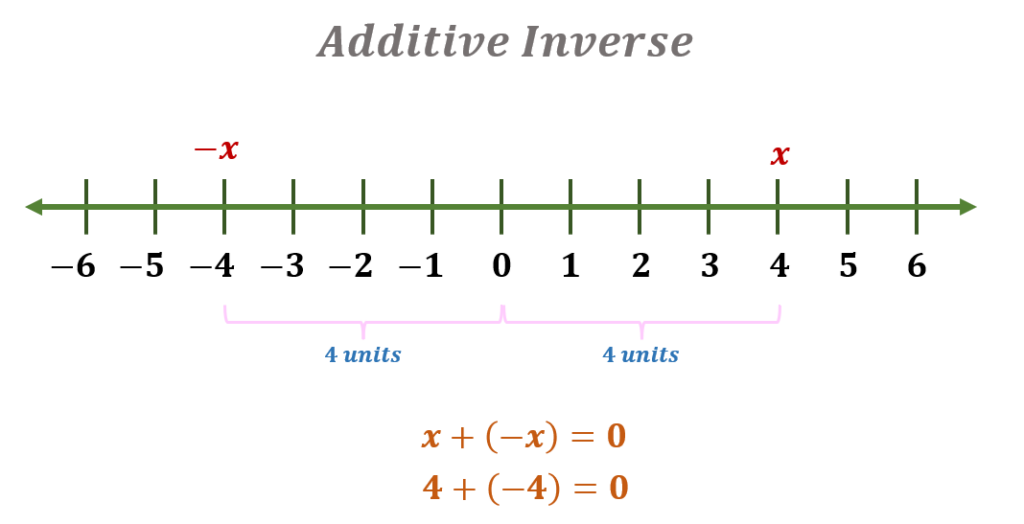Introduction
Mathematics is a beautiful tool for understanding the world around us, and a significant building block of this tool is the concept of additive inverses. Understanding this concept is crucial in studying basic arithmetic, algebra, and beyond. This concept not only aids in solving mathematical problems but also helps understand the balance in the real world.
Grade Appropriateness
The concept of additive inverses is typically introduced in late elementary or early middle school, usually around grade 6. Still, it is an essential concept in algebra, making it relevant for students in grades nine and beyond.
Math Domain
Additive inverses belong to the domain of Number Systems and Algebra. This concept is essential for understanding higher mathematical concepts in algebra, calculus, and even complex numbers.
Applicable Common Core Standards
6.NS.C.5: Understand that positive and negative numbers are used together to describe quantities having opposite directions or values.
7.NS.A.1b: Understand p + q as the number located a distance |q| from p, in the positive or negative direction, depending on whether q is positive or negative.
7.NS.A.1d: Apply properties of operations as strategies to add and subtract rational numbers.
Definition of the Topic
An additive inverse is a number that gives a sum of zero when added to the original number. Essentially, it is the “opposite” of a given number. For any real number x, the additive inverse is -x. Similarly, if the given number is -x, the additive inverse is x.

Key Concepts
Opposite Numbers: Every number has an “opposite” or an additive inverse. For example, the additive inverse of 5 is -5, and the additive inverse of -3 is 3.
Zero Pair: An additive inverse pair, when added together, always equals zero. This is also called a “zero pair”.
Real Number Line: On a real number line, additive inverses are equidistant from zero but in opposite directions.
Discussion with Illustrative Examples
Additive Inverse
The opposite of a number is the additive inverse of the number.
When a number is added to its additive inverse, it results in zero.
A number and its additive inverse have the same distance from zero in the number line.

To get the additive inverse of a number, simply change its sign. A positive number’s additive inverse is a negative number, and vice versa.
Examples
The additive inverse of 6 is -6.
The additive inverse of -8 is 8.
The additive inverse of $\frac{2}{5}$ is -$\frac{2}{5}$.
Additive Inverse Property
The sum of a number and its additive inverse is zero (0).
Examples
6+(-6)=0
-10+10=0
$\frac{4}{5}$+(-$\frac{4}{5}$)=0
-0.89+0.89=0
Examples with Solutions
Example 1
What is the additive inverse of 11?
Solution
The number 11 is positive, so its additive inverse will be negative. The additive inverse of 11 is -11 because 11 + (-11) equals 0.
Example 2
Find the additive inverse of -2.
Solution
The number -2 is negative, so its additive inverse will be positive. The additive inverse of -2 is 2 because -2 + 2 equals 0.
Example 3
What is the additive inverse of $\frac{2}{9}$?
Solution
The fraction $\frac{2}{9}$ is positive, so its additive inverse will be negative. The additive inverse of $\frac{2}{9}$ is -$\frac{2}{9}$ because $\frac{2}{9}$+(-$\frac{2}{9}$)=0.
Real-life Application with Solution
Suppose you owe your friend \$10. In this scenario, your balance can be represented as -\$10. When you repay the \$10, represented as +\$10, you no longer owe anything, and your balance becomes \$0.
This example illustrates the concept of additive inverses in a real-world context.
Practice Test
1. What is the additive inverse of -9?
2. What is the result if you add a number to its additive inverse?
3. What is the additive inverse of 0?
4. What is the additive inverse of 15?
5. What is the additive inverse of -7?
6. What will be my new balance if I have -\$5 and earn \$5?
7. I am at a point 6 steps to the right of zero on a number line. How many steps would I need to take to reach the point that is the additive inverse of my current position?
Answers:
1. The additive inverse of -9 is 9.
2. The result is zero if you add a number to its additive inverse.
3. The additive inverse of zero is zero.
4. The additive inverse of 15 is -15.
5. The additive inverse of -7 is 7.
6. The new balance is \$0.
7. You need to make 12 steps to reach the point that is the additive inverse of your current position.
Frequently Asked Questions (FAQs)
What are the additive inverses in fractions?
The additive inverse of a fraction is obtained by negating the fraction. For example, the additive inverse of $\frac{1}{2}$ is -$\frac{1}{2}$, and the additive inverse of -$\frac{3}{4}$ is ¾.
Can zero have an additive inverse?
Zero is its own additive inverse. When you add 0 to 0, you get 0.
Are additive inverses only for whole numbers?
No. All real numbers, including integers, fractions, and decimals, have additive inverses.
Why is it important to learn about additive inverses?
Understanding additive inverses is vital to mastering the addition and subtraction of integers, which is crucial in algebra and higher mathematics. It also helps in solving real-world problems.
How can I find the additive inverse of a number?
The additive inverse of a number can be found by changing its sign. If it is a positive number, change it to negative; if it is a negative number, change it to positive. The additive inverse of zero is zero.
Recommended Worksheets
Additive Inverse (Valentine’s Day Themed) Math Worksheets
Number Lines (Food Festival themed) Worksheets
Inverse Proportion (Summer Themed) Math Worksheets









